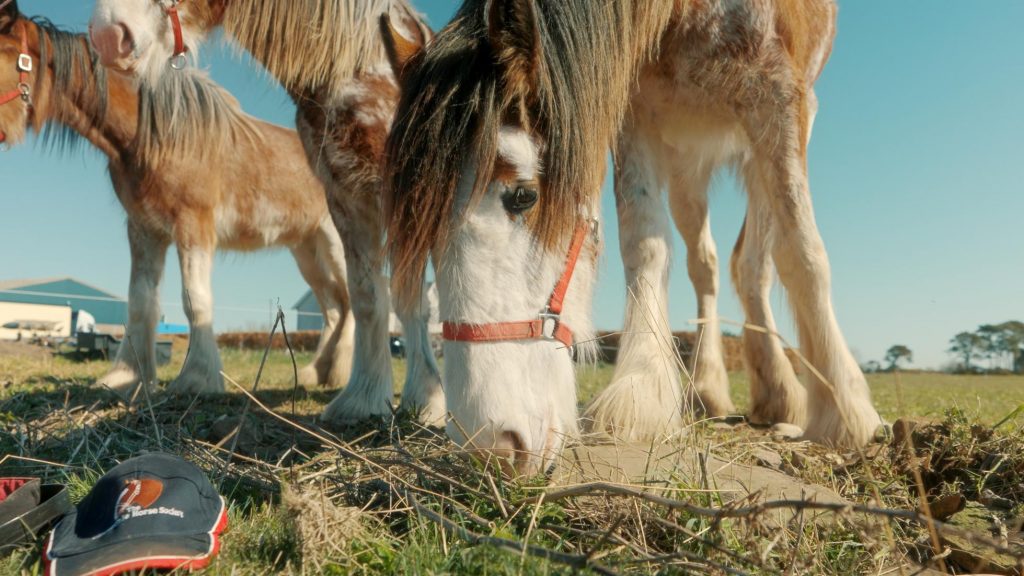On a farm distillery outside Arbroath in Angus, Scotland, the new Drummygar distillery is making Clydesdale horses almost as important a part of whisky production as copper stills and oak casks. Their broad hooves have pressed the soil where Drummygar Distillery’s first barley crop was sown, part of a small but unusual effort to tie Scotch whisky back to older ways of working the land.
Though the role of the Clydesdales is pretty insignificant when it comes to production, it’s a fitting symbol for a distillery shaped by tradition, connection to the land, and patience.
Drummygar is the new venture from Living Souls, the independent bottler founded by industry veteran John Torrance alongside Calum Leslie and Jamie Williamson, both also experienced whisky business hands. Torrance’s decades of experience, stretching from managing distilleries to his time at family whisky firm Douglas Laing, inform the future of the distillery. He also brought in a contact from his professional past. Head Distiller and Operations Director Zak Shenfield worked with Torrance during two separate stints at the Strathearn distillery owned by Douglas Laing, and is now responsible for crafting Drummygar’s future whisky.
Like Strathearn, Drummygar is tiny by Scotch standards. At present, it produces around 30,000 litres of pure alcohol per year, or around 200–250 casks annually. By comparison, in Scotch production distilleries producing ten times this amount are still considered quite small. However, overheads are fairly low. The distillery is located at what used to be a brewery, and it was easy to move in. As Shenfield told me, “We were actually quite lucky. This was formerly the Redcastle brewery, and the place was perfect for what we need. It had the brewing equipment already in place”.
All that needed to happen was the addition of a copper pot stills from Portuguese firm Hoga, and Shenfield is now hard at work defining the distillery’s house style:
“We’re really trying to make a medium to heavy style Highland spirit, and that should be really good for ageing,” says Shenfield. He isn’t interested in trying to produce a lighter spirit that’s more amenable to quick maturation, and therefore quicker returns on investment. Drummygar is planning for releases at least eight to ten years down the line—longer if needed. “We have to make what we like, because you’re the people who are going to be selling it… you have to be passionate about what you’re trying to do”.
This heavier spirit will be laid down in first-fill bourbon barrels and sherry casks initially, with some second- and third-fill casks destined for longer ageing. Barrels are sourced from Speyside Cooperage and from smaller coopers, with plans for additional partnerships as capacity grows.
However, if there’s one detail that has caught headlines, it’s Drummygar’s connection to Clydesdale horses. The distillery sits on a 43-acre farm where the owner breeds Clydesdales for shows. On top of sourcing some of the barley for production from the same farm the distillery is based, a conversation between the Drummygar team and the farmer led to the idea of planting barley with horse-drawn equipment.
This year, they trialled two varietals: Diablo, a modern malting strain, and Chevalier, a 200-year-old heritage varietal. Seven acres of Diablo and one of Chevalier were sown, with one acre of Diablo ploughed and harrowed entirely with the Clydesdales.
Shenfield admits that the massive horses don’t actually affect the flavor or overall production of the whisky: “It doesn’t make a difference to the product. But it’s cool. You know, you don’t see it happening very often. And it’s a real dying art, farming in the old school ways”. For him, it’s about honoring tradition and staying connected to the land.
Unfortunately, not all the results were usable—2025 was a poor year for Scottish malting barley, with much of Drummygar’s local crop downgraded to animal feed. But the plan is to expand next year to 20 acres, with two acres worked entirely by horse.
Meanwhile, the distillery has secured 40 tons of local barley from a farm just down the road, malted traditionally at Warminster Maltings in Wiltshire, which boast the oldest floor maltings in England – a more ‘old-school’ way of malting. “Tradition is such an important part of whisky, and we should be excited about doing things in a traditional manner and really trying to push these techniques, keep them alive”, says Shenfield.
Unlike many new distilleries, Drummygar isn’t leaning on gin, vodka, or white rum for early cash flow. Shenfield believes the time of the gin boom has passed, and prefers to focus all attention on whisky. “Every single new product we do, we take away from our focus on making good whisky,” he says. Instead, the backing of Living Souls’ bottling arm and Torrance’s umbrella company Torrance Premium Spirits provides financial cover until whisky is ready.
That focus includes plans for variety within Drummygar’s whisky itself. Shenfield intends to experiment with heritage barley varietals, super-heavily peated spirit for blending, and alternative wine cask maturations, and fully intends to offer a wide spectrum of flavor to future fans: “Over the next probably five years, we’ll really start to create that portfolio of spirits. So when it comes to releasing products, we’ll have lots of interesting things for people to taste”.

